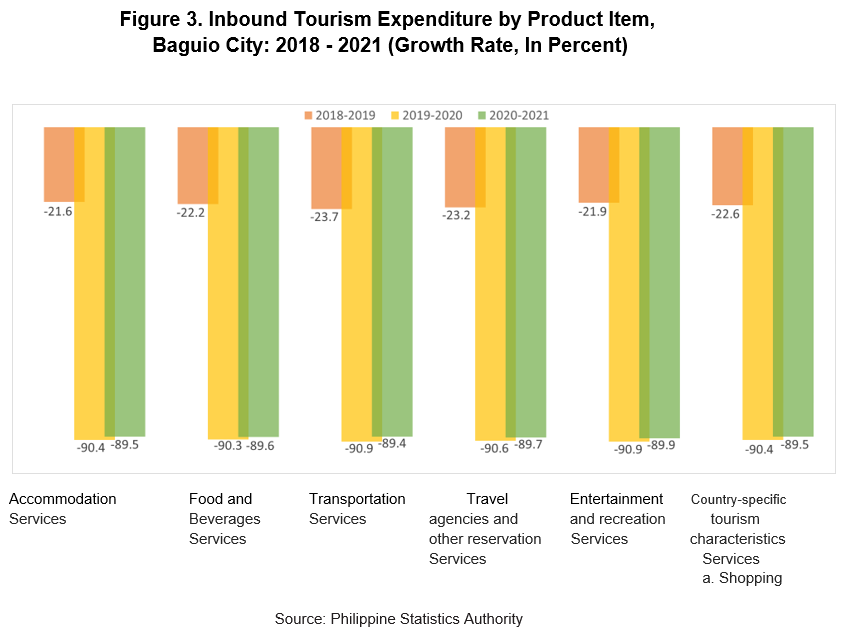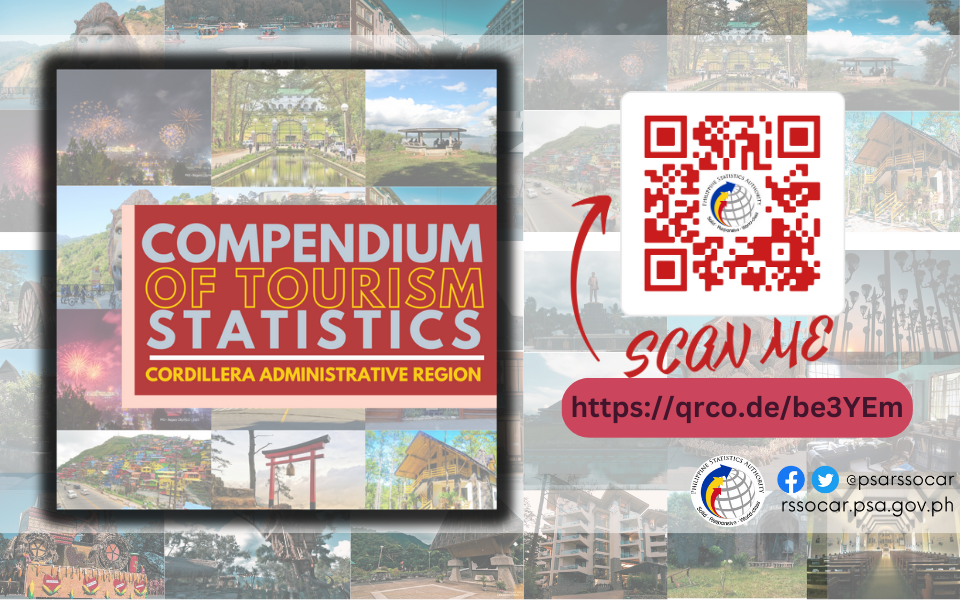The Philippine Statistics Authority - Cordillera Administrative Region (CAR) takes the lead in the estimation of subnational Tourism Satellite Accounts (TSA). In line with the "Tourism Act of 2009" or Republic Act No. 9593, TSA highlights the significance of tourism as an essential component of the national economy through an internally-agreed upon framework of measuring tourism’s economic contribution. The CAR TSA also breaks down the regional tourism accounts into provincial and highly urbanized city (HUC) to assist local-level development planning.
Inbound tourism comprises the activities of a non-resident visitor (foreign and overseas) within the country of reference/locality on an inbound tourism trip (IRTS 2008, para. 2.39b). Inbound tourism consumption comprises the tourism consumption of a non-resident visitor within the economy of reference.

The Average Daily Expenditures (ADE) of an inbound tourist in Baguio City were estimated at PhP 7,227.78 in 2018, continued to increase to PhP 7,357.33 in 2019, PhP 7,361.21 in 2020, and PhP 7,586.68 in 2021. The ADE of an inbound tourist in Baguio City reflected an increasing trend throughout the four-year period. Across tourism expenditures, an inbound tourist spent most on transportation services while the least on entertainment and recreation services. The annual average growth rate of the average daily inbound tourist spending was PhP 119.64.

Total inbound tourism expenditure in 2018 was estimated at PhP 691.89 million, decreased to PhP 534.64 million in 2019, PhP 50.29 million in 2020, and further decreased to PhP 5.27 million in 2021. Inbound tourism expenditure continued to drop due to travel restrictions to inbound tourists.
Transportation services was the main contributor to the inbound tourism expenditure across the four-year period, followed by Accommodation services for visitors, and Travel agencies and other reservation services. Meanwhile, the least contributor throughout the four-year period was Entertainment and recreation services.

Among product items, Transportation services contracted the most in 2019 with -23.7 percent, followed by Travel agencies and other reservation services with -23.2 percent, and then Country-specific tourism characteristic services: Shopping with -22.6 percent, followed by Food and beverage services with -22.2 percent, as well as Entertainment and recreation services with -21.9 percent. Accommodation services recorded the least decline with -21.6 percent.
Entertainment and recreation services and Transportation Services recorded the highest decline in 2020, both with -90.9 percent. This was closely followed by Travel agencies and other reservation services with -90.6 percent, then Accommodation services and Country-specific tourism services: Shopping both with -90.4 percent, and Food and beverage serving services with -90.3 percent.
Entertainment and recreation services and Transportation services recorded the biggest decline in 2021 with -89.9 percent. This was followed by Travel agencies and other reservation services with -89.7 percent, Food and beverage serving services with -89.6 percent, then Accommodation services and Country-specific tourism characteristic services: Shopping, both with -89.5%, and Transportation services with -89.4 percent.

With a regional share of 77.8 percent in 2021, Baguio City accounted for the most inbound tourist expenditure in the Cordillera. Mountain Province came in second with 12.4 percent, followed by Kalinga with 9.8 percent. In 2021, Abra, Apayao, Benguet, and Ifugao were closed to inbound tourists due to the continuing travel restrictions brought about by the COVID pandemic.
(SGD)
VILLAFE P. ALIBUYOG
Regional Director
___________________________________________
TECHNICAL NOTES
Tourism Satellite Accounts - an accounting framework adopted by the United Nations (UN) and is designed to measure goods and services associated with tourism activities according to international standards, concepts, classifications and definitions.
Inbound Tourism - comprises the activities of a non-resident visitor (foreign and overseas) within the country of reference on an inbound tourism trip (IRTS 2008, para. 2.39b).
Inbound Tourism Consumption - comprises the tourism consumption of a non-resident visitor within the economy of reference.
Domestic Tourism - refers to the activities of a resident visitor (overnight and same-day) within the country of reference either as part of a domestic tourism trip or part of an outbound tourism trip (IRTS 2008, para. 2.39a).
Domestic Tourism Consumption - refers to the tourism consumption of a resident visitor within the economy of reference.
Internal Tourism - refers to the activities of resident (domestic) and non-resident (inbound) visitors within the country of reference as part of domestic or international trips.
Internal Tourism Consumption - refers to the tourism consumption of both resident and non-resident visitors within the economy of reference. It is the sum of domestic tourism consumption and inbound tourism consumption.
Internal Tourism Expenditure - the sum of inbound and domestic tourist expenditure.



